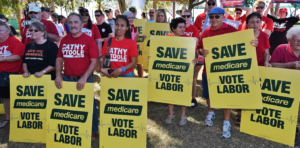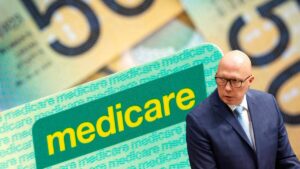 Written by Kushan Nawagamuwage
Written by Kushan Nawagamuwage
Despite the country still reeling from the effects of the COVID-19 pandemic in 2022, the bulk billing rate of General Practice appointments had started to fall from 88% to where it sits now at around 78%. Coincidentally, May 2022 also marked the start of a series of rate increases by the RBA to stem rising inflation.
With cost of living pressures squeezing home budgets, more and more Australians couldn’t afford to access a GP due to the rising cost of healthcare provision. In turn, the demand on public hospital emergency departments increased, and with some people delaying or deferring seeing a doctor – many more patients were presenting later at hospitals with preventable chronic conditions, further exacerbating the strain on an already overburdened system.

Stronger Medicare is “the beating heart” of Labor’s election campaign.
So, it’s no surprise that Prime Minister Anthony Albanese has made Medicare a centrepiece of his re-election campaign with a commitment of $8.5 billion of investment in Medicare to increase bulk billing rates to “9 out of 10 visits” by 2030. Under the policy, Medicare payments for bulk-billed appointments will be increased depending on location, from $42.85 to $69.56 for a standard consult in a metropolitan area and up to as much as $86.91 in a remote area. The investment also promises to deliver 400 nursing scholarships and 2,000 new GP trainees a year by 2028, seeking to address the workforce shortages.

Labor’s “Mediscare” campaign was first introduced during the 2016 federal election.
And of course, with the Government fighting off the threat of a ‘hung parliament’ this election, it only makes sense to dust off the ‘Mediscare’ campaign – an old but reliable chestnut. Opposition Leader Peter Dutton is an easy target.
As Health Minister, it was Dutton who froze the indexation of the rebate for at least four years and supported the policy for a $7 GP co-payment during the Abbott Coalition Government to make Medicare ‘more sustainable.’

Shortly after Labor’s announcement, the Coalition promised to match the Medicare investment “dollar for dollar”.
There is no doubt that the Medicare investment commitment is good politics. Free doctor visits will resonate in the outer suburbs where cost of living hits the hardest and largely where the election will be won or lost – which is essentially why the Coalition was quick to support it dollar for dollar. There’s also the likelihood that any opposition member who questioned the affordability of it would have been met with vicious gnashing of teeth – although we need only look to Victoria to see the long-term consequences of big spending without necessarily having an eye towards appropriate funding models, rising debt, and interest payments.
In unpacking the announcement, it’s clear there may be a few market hurdles to overcome. The rebate boost is only available to general practices who bulk bill all its patients and private consultations would remain the same at $42.85. According to recent government data the gap fee for patients is currently between $40 to $45 dollars which represents a total GP fee of around $88 for a standard private consultation. Given this, many general practices will start doing the math around what their fees could look like under the new rebates and anticipated new patients, in comparison to the costs they incur in running their medical practice and may or may not decide it’s financially viable to bulk bill.
Putting aside fees, notably, the policy doesn’t seem to address the larger reality that Australia’s health system is highly fragmented, and many people are presenting to emergency departments with health conditions that need holistic models of care and innovative funding models to match.
This is where the National Health Reform Agreement (which was extended for another year by the government in a flurry of a $1.7 billion cash splash to state hospitals) can invest and implement in innovative models of care, incorporating community health and incentivising GPs to work as part of a person’s healthcare team, and developing holistic care plans tailored to a patient’s health-care needs, inclusive of mental health support, dental, allied health and nurse practitioners who can assist with requesting and interpreting tests, prescribing medication, and assisting with ongoing care plan management.
Ultimately, any investment to improve access to universal healthcare is never a bad thing. But for the investment to be good policy and sustainable, it will need to be coupled with broader structural reforms in partnership with the states, to deliver better health outcomes for Australians – that would be the real legacy piece.
Given our team’s experience and hawk-eye position, if you need any assistance navigating the challenging government relations path ahead, please do not hesitate to reach out.


